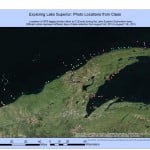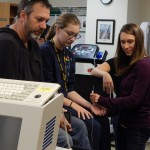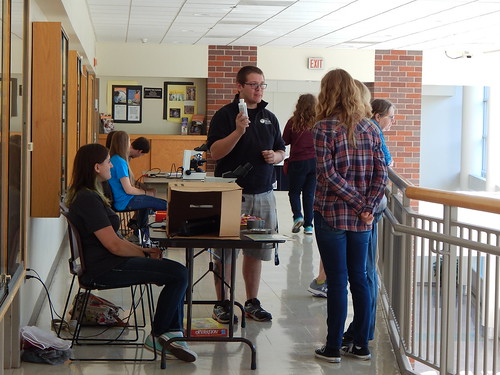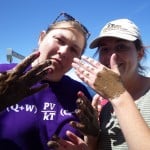 Joseph Wagenbrenner (SFRES/GLRC), is the principal investigator on the project Informing Great Lakes Connectivity Decisions: An Enhanced Online Portal for High-Resolution Barrier Data and Species-Specific Benefit Analysis, that has received a $42,105 research and development grant from the University of Wisconsin. Casey Huckins (Bio Sci) and David Watkins (CEE) are co-PIs on the two-year project.
Joseph Wagenbrenner (SFRES/GLRC), is the principal investigator on the project Informing Great Lakes Connectivity Decisions: An Enhanced Online Portal for High-Resolution Barrier Data and Species-Specific Benefit Analysis, that has received a $42,105 research and development grant from the University of Wisconsin. Casey Huckins (Bio Sci) and David Watkins (CEE) are co-PIs on the two-year project.
 The new coaching schedule and hours of operation for the Biology Learning Center are now posted to the BLC web page.
The new coaching schedule and hours of operation for the Biology Learning Center are now posted to the BLC web page.
 “Where Do Young Lake Sturgeon Go After They Hatch? A Close Inspection of River Habitat.” Features research conducted by Dr. Nancy Auer. You can read the full article in their on-line magazine “Fish Lines.”
“Where Do Young Lake Sturgeon Go After They Hatch? A Close Inspection of River Habitat.” Features research conducted by Dr. Nancy Auer. You can read the full article in their on-line magazine “Fish Lines.”
Updated with a map  showing the GPS locations for the pictures taken by Colin Brooks. Each color represents a different day; each dot indicates the GPS location that Colin’s GPS linked camera recorded. They covered a lot of water!
showing the GPS locations for the pictures taken by Colin Brooks. Each color represents a different day; each dot indicates the GPS location that Colin’s GPS linked camera recorded. They covered a lot of water!
See photos from the BL5421 course Lake Superior Explorations on the GLRC Flickr page.
Also see the list of YouTube videos including aboard the research vessel as well as underwater footage.
 Congratulations to Dr. John Durocher and colleagues on their new publication:
Congratulations to Dr. John Durocher and colleagues on their new publication: See the original Michigan Tech Article here
See the original Michigan Tech Article here
Released: 13-Aug-2015 1:05 PM EDT
Source Newsroom: Michigan Technological University
Mine waste is dangerous to human and environmental health. The recent mine waste spill in Colorado is a stark reminder of that, but while details on the event may be sparse, the science behind remediation is not. Rupali Datta, an associate professor of biology at Michigan Tech, delves into how the heavy metals found in mine waste affect biological systems. She focuses on biochemistry and genetics to understand how metals are taken up by plants and animals–and how those metals are detoxed.
“The impacts from acid mine drainage affect the aquatic ecosystem mainly due to very low pH and high levels of bioavailable heavy metals,” Datta says, “Which can severely affect the biological community structure.”
Datta collaborates with Dibs Sarkar, a professor of environmental geochemistry in Montclair State University, New Jersey who is also an adjunct professor at Michigan Tech. They work on an abandoned coal mine site in Southern Illinois, testing the effectiveness of a “green” technology that they have developed to combat acid mine drainage problems in impacted water and soils. Sarkar says the spill is not a unique situation and could have been prevented.
“This was a totally avoidable situation,” he says. “It shouldn’t have happened with proper oversight, which unfortunately, is the case with many mine sites that produce acid mine drainage.”
Acid mine drainage is a routine problem in surface coal mines and metal mines, but are mostly not properly managed and the sites are abandoned. This current spill, which is from the Gold King Mine into the Animas River outside Durango, Colorado is getting media attention because of its scale, which is so vast that it would be difficult to fully gauge its impact on the environment right away. Long term impacts of the spill on the Animus River basin will need to be studied carefully. Datta and Sarkar do say the Environmental Protection Agency has taken quick steps to tackle the situation.
“However, their treatment process is generating a huge amount of solid waste in the form of contaminated sediments that they have to deal with down the road, and I hope, they will look for “green” methods instead of just dumping them in landfills,” Sarkar says.
Datta and Sarkar are available for comment on the Colorado spill to better put the event in the context of remediation science and long-term impacts of heavy metals.You can reach Rupali Datta at rupdatta@mtu.edu, office: 906-487-1783 and Dibs Sarkar atdsarkar1@mtu.edu, office: 973-655-7273
 Congratulations to Dr. Xiaoqing Tang and her team on their new publication in JBC. Here is the link:
Congratulations to Dr. Xiaoqing Tang and her team on their new publication in JBC. Here is the link:
 Dr. Kerfoot and collaborators have a new publication:
Dr. Kerfoot and collaborators have a new publication:
http://onlinelibrary.wiley.com/doi/10.1111/fwb.12653/full
 Xiaoqing Tang (Bio Sci) received a $75,000 research contract from the U.S. Highbush Blueberry Council for the project Blueberry Protects Pancreatic Beta-Cells
Xiaoqing Tang (Bio Sci) received a $75,000 research contract from the U.S. Highbush Blueberry Council for the project Blueberry Protects Pancreatic Beta-Cells


